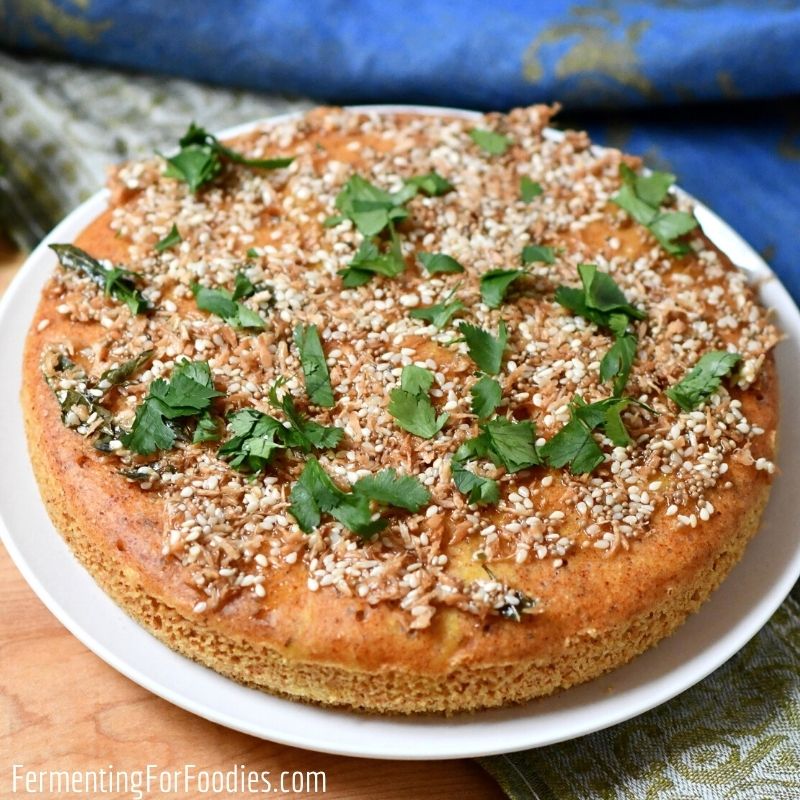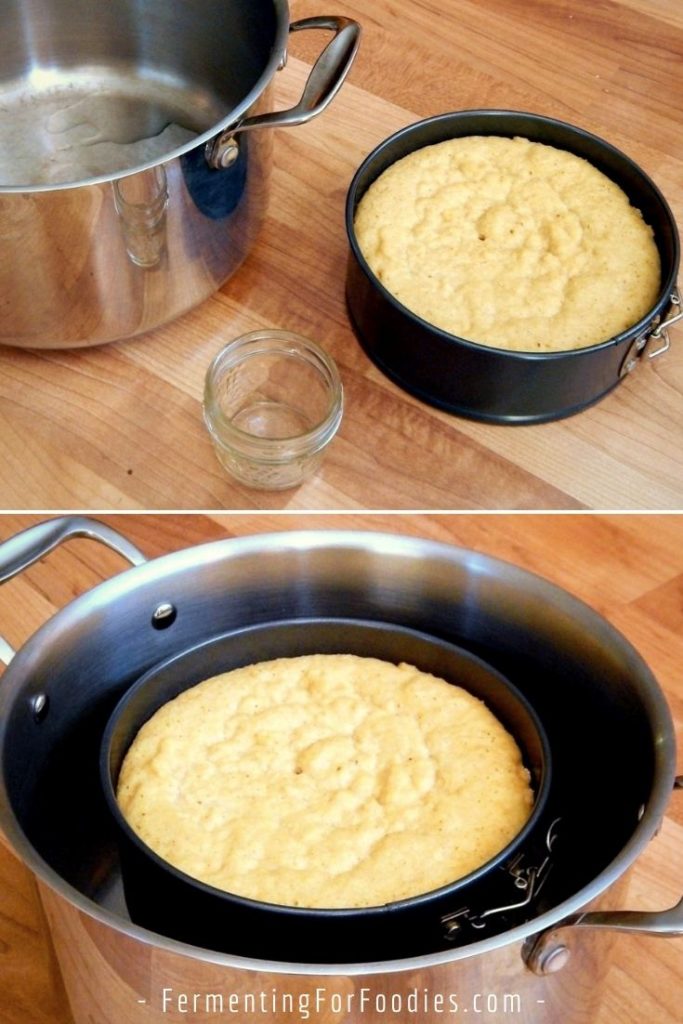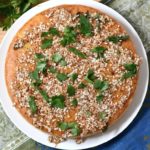What exactly is khaman dhokla? Well, a dhokla is an Indian steamed bread made from a fermented batter. Like a dosa, it can be made from all sorts of different grains: rice, semolina, lentils, and chickpeas.

Dhokla has a cake-like structure. It is traditionally eaten for breakfast or snack. It also works as an appetizer. Serve it with your favorite Indian pickle or chutney.
I have made dhokla with soaked lentils and rice, which are then ground up (like a dosa or idli). This recipe is much simpler. It uses chickpea flour and rice flour, so it avoids the grinding required with other dhokla recipes.
DIY Steamer
If you don’t have a steamer here is a simple alternative. I’ve used it for everything from a steamed British pudding to fermented khaman dhokla.
- Pour batter into a greased 6-inch cake pan or a greased pudding bowl that is small enough to nest inside a large pot.
- Put 2-inches of water into the bottom of the pot.
- Place a glass jar on the bottom of the pot that is tall enough to sit just above the water level. A small jam jar works well.
- Place your pudding bowl on top of the jar.
- Steam with the pot lid on, occasionally checking the water levels. To keep the water from dripping off the top of the pot onto the pudding, either cover the pudding with tinfoil or wrap the pot lid in a tea towel.

Khaman Dhokla
Khaman dhokla is an Indian steamed bread made from a fermented batter. It is traditionally eaten for breakfast or snack but is also nice as an appetizer.
- Prep Time: 5 minutes
- Cook Time: 15 minutes
- Total Time: 20 minutes
- Yield: Serves 6-8 1x
- Category: Side Dish
- Method: Steamed
- Cuisine: Indian
- Diet: Gluten Free
Ingredients
Ferment
- 3/4 cup chickpea flour
- 1/4 cup rice flour
- 1/2 cup yogurt
- 1/4 cup filtered water (chlorine-free)
Remaining Ingredients
- 1/2 tsp ground cumin
- 1/4 tsp turmeric powder
- 1/2 tsp baking soda
- 1/4 tsp salt
- 1 tsp oil
Topping
- 1 Tbsp oil
- 1 Tbsp shredded coconut
- 2 tsp sesame seeds
- 1 tsp mustard seeds
- 1 diced chili and 5 curry leaves (optional)
- 2 Tbsp cilantro
Instructions
- Mix the chickpea flour, rice flour, yogurt, and water in a glass container and allow to ferment at room temperature for 8-12 hours.
- When you are ready to make the dhokla, mix in the spices, baking soda, and oil.
- Pour the batter into a 6-inch cake pan, cover with tinfoil, and steam for 15-25 min (until a knife comes out clean). See the section above for an easy homemade steamer.
- Heat the oil and fry the spices and coconut until they are fragrant and just starting to brown.
- Pour the toasted spices over the freshly steamed dhokla. Top with cilantro and serve warm.
Notes
- Though yogurt is traditional in this recipe, feel free to substitute it with milk kefir or buttermilk.
- Instead of chickpea flour, you could use just rice flour, lentil flour, garfava flour, etc. Though changing the flour would officially change the type of dhokla, it doesn’t really affect the recipe.




I am going to try this this week. I have really been enjoying your blog. I used to make tempe. We were making it in 1993. Then I started having a lot of failures. Thought it might have been the soy beans. I am interested in trying again.
Thank you! I’ve never had a tempeh failure… so maybe it was your culture? Good luck this time around!
I have read that fermented vegetables are a cause of stomach cancer in Asia and if you do a web search there are a lot of scientific studies to back this up. I love fermenting veggies so am worried. Have you heard this? Thanks
I know that too much sausage and fermented meats can cause cancer because of the salt and nitrates. And kimchi, with fermented hot peppers can be problematic, because the hot peppers are hard on the stomach. Sauerkraut and other fermented vegetables are beneficial for your stomach and digestive system. However, if you have issues with salt, try using less salt in your ferments by using a good vegetable starter. (I think I link to one in my Resources section).
Keep Fermenting! Emillie
Can I use greek yogurt or plain yogurt instead of Kefir?
Yogurt or kefir will both work. I would avoid Greek yogurt as it is too thick.
Hi Emilie! I want to make this recipe and start exploring more fermented foods. Your website will definitely serve as knowledgeable inspiration! Thank you for being here 😉 Now, since I am a complete beginner when it comes to fermenting, I need to ask you, do I ferment at room temperature or in the fridge?
Fermentation always occurs at room temperature. Things may ferment in the fridge, but it really slows everything down. So I store stuff in the fridge when I want to stop the fermentation. 🙂 I recommend checking out this post on basic fermentation advice: https://www.fermentingforfoodies.com/how-to-ferment/
Cheers, Emillie
Thanks Guys, Your Recipe Was Too Fantastic. Me and My Family Loved it. I Will definitely Share your Rrecipe with my friends.
Thanks!